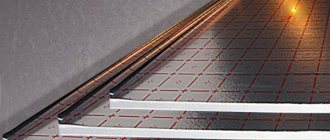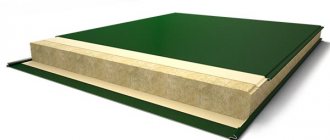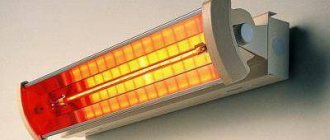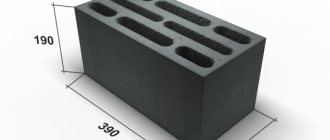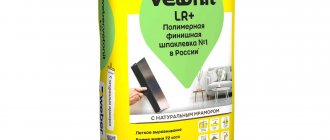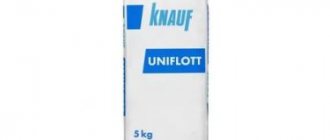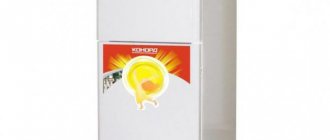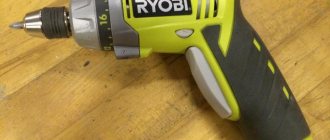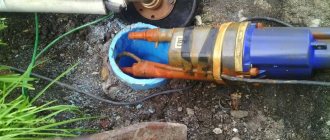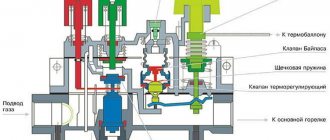Thermal insulation materials from URSA have become very popular recently. They are used for traditional insulation of walls and roofs, and are also used as insulation for ventilation pipes and other communications. Using such materials you can significantly reduce the noise level in the room.
URSA is an insulation material whose technical characteristics are always at the highest level. The service life of the heat-insulating substance is very long. Due to its ability to retain heat efficiently and perfectly absorb noise, URSA insulation is used in absolutely any modern building structure.
Features of Ursa material
Ursa insulation based on fiberglass
Universal Ursa insulation effectively reduces heat loss and creates a comfortable microclimate in the room. Low specific gravity helps reduce the volume of building materials and energy consumption.
The URSA brand produces 2 types of products:
- thermal insulation based on Ursa expanded polystyrene (EPS);
- based on fiberglass.
The first category includes material made using extrusion technology. The foam particles combine with the foam under pressure and heat. The hot mass passes through the extrusion head of the unit and Ursa extruded polystyrene foam is obtained.
Insulation of the second category is produced by combining dolomites, quartz sand and soda. The substances are melted, and additives are added to the mass to glue the components together. The hot composition is forced through the nozzles of the extrusion unit.
Types and characteristics of Ursa mineral wool insulation
Ursa mineral wool insulation, the characteristics of which make it possible to call it the most environmentally friendly thermal insulation among all its competitors, is represented in three positions in the line. Each of them has its own characteristics, so they need to be considered separately.
Mineral wool Ursa Geo
Ursa fiberglass.
Produced in the form of rolls and slabs. This is a fiberglass material based on quartz sand. A special production technology eliminates the use of harmful substances, including formaldehyde. Ursa insulation, technical characteristics:
- thermal conductivity lambda 0.035-0.044 W/m*C;
- vapor permeability 0.51-0.64 mg/m*h*Pa;
- moisture absorption no more than 1 kg/m. kv;
- does not burn;
- operating mode from -60 to +300 degrees.
The manufacturer provides three options for roll widths: 600 mm, 610 mm and 1200 mm. Thickness can be 10, 50, 75, 100 and 200 mm. Such a variety of dimensions of Ursa insulation, according to reviews, allows you to select thermal insulation as accurately as possible for any type of work. The line also includes universal thermal insulation boards with a thickness of 50 and 100 mm. Ursa slab insulation, dimensions:
- standard width 600 mm;
- length 1000 or 1250 mm.
They can be used on all surfaces, both outside and inside. The exception is the insulation of the bathhouse.
Proper installation of a roof vapor barrier will allow you to avoid wetting of the insulation and associated problems during operation.
You can read about which vapor barrier is best for the floor here.
Mineral wool Ursa Terra
Quartz sand slabs made using new technology.
This type of thermal insulation is also available in rolls and slabs. This can be read by the markings:
- PN – plates, from the English word plates;
- RN – rolls, from the English word rolls.
Ursa insulation characteristics:
- thermal conductivity lambda 0.034-0.039 W/m*C;
- flammability class G1;
- water absorption no more than 1 kg/m. kv;
- temperature range from -60 to +220 degrees.
The thickness of the slabs is 50 and 100 mm, the standard width is 600 mm, and the length is 1000 and 1250 mm. Sound insulation in slabs 610 mm wide and 1000 mm long has a thickness of 50 mm. Thermal insulation in rolls is available in widths of 1200 mm and thicknesses of 50 and 100 mm.
Ursa Terra is used mainly for wall insulation. This includes laying thermal insulation in the inter-wall voids of frame houses, and installation outside using ventilated facade technology. To protect the material, windproof films and waterproofing are additionally used.
Extra pure mineral wool Ursa PureOne
Ursa PureOne is the most environmentally friendly material in the line, soft like cotton.
Ursa PureOne roll insulation is positioned by the manufacturer as the most environmentally friendly material in the line. It is made from quartz sand, without the use of formaldehyde, components of plant origin and recycled materials. The acrylic-based binding component makes the thermal insulation absolutely harmless to humans. This material is white, looks like natural cotton, does not irritate the skin and does not generate dust. PureOne is recommended for use in children's rooms.
The Ursa insulation material (seen in the photo) is very elastic and has shape memory. Thanks to this, it completely restores its volume after opening the polymer packaging. Installation between the guides can be carried out without adhesives, just by surprise. Available in mats and slabs. The thickness of the mats is 50, 100 and 150 mm. The dimensions of the slabs are 600x1250 mm, and the thickness is 50 and 100 mm. Thermal conductivity is indicated on the label. For example, Ursa PureOne 37RN means that the insulation is in rolls with a thermal conductivity of 0.037 W/m*C.
A polymer film or foil insulation can be used as a vapor barrier for a bathhouse.
The correct calculation of liquefied gas consumption for heating is outlined here.
Technical characteristics of mineral insulation
Indicators of the density and size of roll insulation and Ursa boards
The category of mineral insulation includes materials made from natural components, for example, fiberglass. Products are sold in slabs or rolls. The structure does not include phenolic substances to bind the ingredients, so Ursa mineral wool is an environmentally friendly product.
The composition contains sand, soda, and other non-combustible materials, so the insulation is characterized by increased fire safety indicators. The manufacturer indicates a period of 40-50 years of operation without destruction or loss of quality.
Insulation density
The density of a material is determined by the ratio of weight to volume. For glass wool, the indicator is determined on a scale of 15-85 kg/m3, depending on this the area of use is selected. In private houses, material with an index of up to 30 kg/m3 is used, and industrial insulation requires penoplex of higher density.
Thermal conductivity
The characteristic shows the ability of rolled and slab materials to conduct heat from heated to cold layers. Energy transfer occurs due to the movement of elementary particles in the insulation composition. Ursa mineral wool has a low ability to transfer heat, so it provides good insulation of structures and pipelines.
The lower the thermal conductivity coefficient, the better the protection from cold. For mineral wool, the indicator is within the range of 0.031-0.045 W/mK. This amount of energy passes through the thickness, which indicates the high thermal insulation qualities of the layer.
Application temperature
Technical characteristics of flammability and thermal conductivity
The characteristic determines the temperature range at which the insulation retains its specified properties. The manufacturer guarantees that Ursa polystyrene does not change its declared qualities at ambient temperatures down to -60˚C. The upper value is +310˚С.
These indicators relate only to the atmosphere, since the insulation surface can withstand other temperature loads, the limit of which is +100˚С, and some categories retain properties at +180˚С. The insulation belongs to the universal class and is suitable for protecting various structural elements from cold in any climate conditions.
The material is sold in the form of rolls or in the form of slabs. Rolled products are produced in thicknesses of 5-20 cm, width varies in the range of 60-120 cm. The length of mats is 3-18 m, and sheets are produced in sizes of 1.25 m.
URSA insulation: characteristics
All the most common products of the URSA company have their own set of individual and unique characteristics that differ from the rest. To choose for yourself exactly the material that is needed for a specific type of repair, you need to study all the characteristics provided.
GEO fiberglass insulation
Main characteristics of GEO insulation:
- It has a high heat conservation capacity because the fibers are long and elastic. Therefore, a large number of air layers will form between them. When insulating a house with this material, you can expect that the walls will not freeze in winter.
- The thermal conductivity coefficient determines how well this insulation copes with the assigned tasks. The higher the parameter value, the better the material will retain heat. GEO has a coefficient of 0.035 to 0.044 watts per meter per Kelvin. This indicator depends on the type of insulation.
- The insulation also has a high level of noise reduction. Its sound absorption class is “A” or “B”. These indicators have been proven through laboratory studies. By and large, all fiberglass materials can block sound waves. That is why, if you want to create good sound suppression in an apartment or private house, then you can safely choose any URSA heat insulator.
- Environmental friendliness. All components undergo strict testing in laboratory conditions for environmental friendliness. The finished insulation is always checked for safety for nature, as well as for humans. The emission of volatile compounds in this material is 10 or 15 times less than Russian and European requirements. The company guarantees that if insulation is installed, the house will always have a favorable microclimate and the cleanest air. But it is necessary to remember that all fiberglass products will generate a little dust during installation, and therefore it is best to cover the interior parts of the premises with waterproofing material.
- GEO thermal insulator is fire resistant because it is made from quartz sand. Quartz is a natural material that is completely resistant to combustion. If he encounters an open fire, he will not let it into the room. And also the material is completely unaffected by old age. Even after a long period of use, it will not lose its appearance or properties. The manufacturer guarantees a service life of over 50 years.
- Biological resistance. The substance is inorganic, and therefore mice, rats and insects will not try to eat it. Microorganisms such as fungus will not be able to grow in it. There is simply nothing for living creatures to eat there.
PureOne insulation
In production, completely new technologies are used, which were first used in Europe and Russia. Now this development is spreading all over the world. It is used to produce high-quality PureOne material. The essence of the technology lies in the quality of one of the components. We are talking about acrylic - a chemically neutral and safe polymer for humans. It is because of this component that fiberglass will not be as prickly as it is obtained with the standard manufacturing option.
It is also worth noting that less dust will be generated during installation. Acrylic is an inert material, and therefore cannot be dissolved by water or oxidized by air. URSA insulation materials are often used in hospitals and kindergartens .
Noise-absorbing characteristics. All noise absorption tests are carried out by scientists from the Building Physics of the Russian Academy of Sciences. They conducted research and claim that the PureOne tile material has a sound absorption class of “A”, and the insulation in the form of mats has a class “B”.
Acrylic dampens sound waves to a significant extent. Therefore, partitions made of such material will protect against noise effects much better than those made of stone wool or glass fibers. As a result, the difference can be more than 2 decibels.
Elasticity. URSA insulation is more elastic than simple fiberglass. There is a certain springy effect that occurs inside. This allows the material to fit tightly into wall cavities. A particular advantage is that the PureOne form will not lose its original appearance over time.
A line of materials based on mineral components
Mineral wool differs in fiber depending on the initial component underlying it. The structure can be spatial, corrugated, the layers are divided horizontally or vertically.
The manufacturer designates products depending on the raw material composition:
- Fiberglass products are marked with the Geo prefix. The products fall into the category of materials that are safe for humans and environmentally friendly.
- A product with the PureOne index is created on the basis of glass threads. The composition contains acrylic components. This type of insulation is installed to protect against cold in children's institutions and hospitals.
- The non-flammable Terra material is ideal for insulating wooden buildings. The composition includes natural components, the insulation does not harm the environment and humans.
- Thermal insulation based on extruded polystyrene foam is marked with the prefix XPS and is a durable and reliable insulating option for insulation.
Ursa thermal insulation is manufactured in accordance with technological standards that regulate the content of the binder.
Ursa GEO
Material marked Geo is environmentally friendly and does not emit harmful combustion products.
The heat insulator is allowed for use in rooms with a high risk of fire, since the material does not emit harmful components when heated.
Ursa Geo products are available in the following range:
- Light;
- Pitched roof;
- Frame P;
- Mini;
- Facade;
- Noise protection%
- Universal plates.
Mats with one foil side are designated M-11F and M-11, double-sided - M-25F, M-25, M-15. The slabs are marked P-60, P-15, P-45, P-20, P-30.
With a low specific gravity, Geo brand products provide high-quality protection from cold and noise, thanks to the original fibrous structure. The material does not decompose, does not burn, and rodents and insects do not settle in the thickness.
Ursa PureOne
The Pure One material does not emit dust during installation.
The characteristics of Ursa insulation show that the material consists of 95% natural substances, which underwent quality control during the production process. The material is produced in accordance with sanitary international standards and is included in the class of environmentally friendly insulators.
Line names:
- 35QN rolls measuring 1200 mm x 3900 mm;
- slabs 34PN with dimensions 1250 mm x 600 mm);
- rolls 37RN size 1200 mm x 100 mm).
The products are flexible when installed in curved structures due to the thinned fibrous elements in the structure. The material does not emit dust or odor during installation. The white color is obtained through the use of quartz sand.
Ursa TERRA
Terra material is available in the form of slabs.
The products were developed for private buildings, but also meet the requirements of professional construction. Plates of this type are distinguished by their small size and rigidity with sufficient elasticity and flexibility.
The following range of Terra brand insulation is produced:
- slabs 34 PN;
- mats for insulation of highways and ventilation ducts 34 RN.
The sheets are characterized by a good index of thermal and sound conductivity and show moisture-resistant qualities. The production technology involves the use of water-repellent additives.
Ursa insulation - technical characteristics: quality and advantages
High-quality insulation of your home is one of the most important tasks of any homeowner. Of course, with a prudent approach, the owner of the house will strive for high efficiency of thermal insulation, keeping in mind affordable prices for insulating materials, environmental and fire safety of the structure being created. And only a high-quality product from well-known manufacturers can guarantee such a combination.
Ursa insulation technical characteristics
One of the most popular thermal insulation materials is mineral wool, made from environmentally friendly natural raw materials. If we think from the point of view of cost, then the most profitable is the use of mineral wool based on fiberglass. But, it’s true, you can hear a lot of “negatives” about glass wool - low stability, fragility, tendency to collapse and loss of volume, getting wet with moisture, etc. Perhaps all this is true if you purchase incomprehensible material from an unknown manufacturer. But everything is completely different when you select high-quality Ursa insulation, the technical characteristics of which will be discussed in detail in this publication.
A few words about the history of the URSA brand
The corporate logo of the URSA trademark cannot be confused with any other - these are the silhouettes of a polar bear with a bear cub. This is exactly how the word “ursa” is literally translated from Latin. This trademark received official registration not so long ago - in 2002, but the history of the production of thermal insulation and building materials of this company is much richer.
Original, easily recognizable "URSA" logo
The origins should be sought at the beginning of the twentieth century - in 1907, the Spanish entrepreneur Jose Roviralta decided to organize the production of building materials based on fiber cement, innovative at that time. It is interesting that mineral rocks delivered from Russia - from the Ural Mountains - were initially used as raw materials. This circumstance gave it its name, which literally means “Ural stones”.
The business, as they say, took off, began to expand, and pretty soon URALITA products became recognizable and in great demand throughout Europe, and it itself turned into a transnational concern.
At the end of the last century, Poliglas, a leader in the production of thermal insulation materials, also became part of the concern. Then a logical decision was made to unite all research and production facilities operating in the insulation materials sector under a single brand - and thus the “polar bear” - “URSA” was born.
Nowadays, products under the URSA brand are produced at 14 enterprises located in various European countries. Three powerful plants operate in Russia - in the city of Chudovo, Novgorod region, and the city of Serpukhov, Moscow region.
It is interesting that the plant in Chudovo is the oldest division in the entire structure of the URALITA concern - this enterprise, which previously specialized in the production of glass, dates back to 1876. Now it is a powerful, completely modernized enterprise that meets the most stringent international standards of quality and environmental safety.
Find out useful information about which insulation mice cannot chew from our new article on our portal.
URSA product lines
The main volume of products of the URSA brand is mineral wool insulation based on glass fiber, produced using a special technology developed by the company’s specialists, which eliminates or minimizes the characteristic disadvantages of glass wool. However, the URSA assortment is not limited to this - completely innovative developments of fibrous thermal insulation materials URSA PUREONE and insulation based on extruded polystyrene foam URSA XPS are on sale. In addition, the production of special membrane coatings necessary for creating effective thermal insulation systems is envisaged.
Insulating materials of the “URSA GEO” line
This is the most common material in the company’s assortment. Its basis is fiberglass, made from purified quartz sand with mineral additives. The special eco-technology of GEO production, the subtleties of which are, of course, a production secret, makes the products absolutely safe for humans and the environment - the canons of the modern approach to “green building” are observed.
All types of URSA products meet the requirements of the highest environmental standards
- Although in the production of mineral wool insulation it is not yet possible to do without organic binders, their emissions in URSA GEO are reduced to almost zero, that is, a clean and healthy atmosphere will be maintained in the premises.
- The most important advantage of URSA GEO insulation is its non-flammability and resistance to high temperatures. The material not only does not ignite, but also prevents the spread of flame.
- The material has a pronounced biostability - it does not lend itself to decay or decay, and does not serve as a breeding ground for any forms of life.
- Convenient forms of release of insulation from the URSA GEO line significantly simplify the installation of thermal insulation structures. Despite their apparent fragility, glass fibers have excellent strength and elasticity. In some cases, the installation of insulating boards or mats will not even require additional fixation.
- Thermal insulation “URSA GEO” stands out from the general background due to its increased durability - it does not fall off, does not lose its shape or performance characteristics, and is capable of serving faithfully for at least 50 years.
The URSA GEO product range includes about 20 items. It makes sense to consider those that are most often used in individual construction.
- "URSA GEO M-11"
“URSA GEO M-11” mats
This type of insulation can easily be considered one of the most popular - it is characterized by increased versatility, and is used in almost any area of private construction to create thermal insulation or sound insulation structures:
- for insulation of interfloor or attic floors along beams or joists.
- for insulating frame walls or creating soundproofed internal partitions.
- can be used as insulation in multi-layer brick or stone walls.
- excellent for insulating loggias and balconies.
- used for thermal insulation of pipelines or ventilation ducts.
Available in rolls of various lengths and widths - very convenient for self-assembly.
- "URSA GEO M-11 mini"
Reduced release format - “URSA GEO M-11 mini”
In the practice of private housing construction, there are often areas for which it is more convenient to use small-format material for insulation or sound insulation. The manufacturer has thought through this issue - “URSA GEO M-11 mini”, being in terms of operational parameters an analogue of the type presented above, is produced in the form of narrow mats rolled into rolls. This greatly simplifies the transportation of material by personal transport and carrying out independent installation work.
Prices for URSA insulation
URSA insulation
- "URSA GEO Private House"
The name of the type speaks for itself - this is a product of increased versatility, designed specifically for use in individual construction or for insulating apartments.
Universal mats “URSA GEO Private House”
Excellent for insulating floors along beams or joists, for thermal insulation of frame walls, for the construction of internal lightweight partitions with the required level of sound insulation.
The packaging of the material is convenient - it is designed for 20 m², which facilitates calculations when planning construction or repair work.
- "URSA GEO Light"
If the owners are primarily interested in the cost-effectiveness of thermal or sound insulation work, then you can choose a “lightweight” version of the insulation - “URSA GEO Light”.
The most affordable type of insulation is “URSA GEO Light”
This material also has versatility - it can be used in horizontal unloaded insulating structures (floors and ceilings on beams and joists), as well as for acoustic ceilings and interior partitions.
- "URSA GEO Pitched Roof"
A material with a specific purpose - created specifically for insulation of pitched roofing structures. At the same time, it creates reliable thermal insulation of the roof and highly effective protection against the penetration of external noise, which is especially important for attic living spaces.
"URSA GEO Pitched Roof"
In the production of this type, a special technology is used - “URSA Spannfilz”, which can be translated as “elastic felt”. The slabs have pronounced elasticity and fit perfectly between the rafter legs, thereby ensuring good fixation and the absence of “cold bridges”.
The form of release is also interesting - slabs in a roll. This makes it possible to easily cut material in any direction, minimizing waste at non-standard distances between rafters.
- "URSA GEO Universal Plates"
In some cases, for carrying out ordinary insulation work in a house or apartment, it is more convenient to use separate slabs rather than rolled mats. This is also included in the product line - you can purchase universal plates.
Insulation in piece format: “URSA GEO Universal boards”
The main purpose of this material is to insulate wall structures and create soundproof partitions. However, it is not for nothing that they are called universal - the slabs are quite suitable for thermal insulation of floors, pitched roofs, cold floors along joists, balconies and loggias.
The convenient length and width of the slabs (600 × 1000 mm) will greatly facilitate their installation in conditions, for example, in cramped rooms or limited work space.
- "URSA GEO Noise Protection"
A special type of material intended primarily for use in the construction of internal frame partitions. It has pronounced noise-absorbing properties (sound absorption class B). The special roll size (width – 610 mm) is designed for installation between frame guides located at a standard pitch of 600 mm.
Mats “URSA GEO Noise Protection”
However, such mats can also be used for insulation and soundproofing of floors, and creating acoustic ceilings.
- "URSA GEO Frame"
The main purpose of this variety is thermal insulation of structures on a metal or wooden frame. The range of thicknesses - from 100 to 200 mm allows you to effectively insulate walls during the construction of frame houses that are so popular in our time.
Especially for frame structures - “URSA GEO Frame”
Designed mainly for vertical wall structures. The material has a high degree of elasticity (thanks to the already mentioned URSA Spannfilz technology), which ensures the stability of the thermal insulation layer and the absence of “cold bridges”. It can also be used as an insulating middle layer for “well masonry”, for insulating roofs and ceilings along joists or beams. It can be used to create an insulated ventilated facade, but with the obligatory use of a windproof, vapor-permeable membrane.
Belongs to the category of professional insulation materials.
- "URSA GEO Facade"
Fiberglass-based slabs designed exclusively for external wall insulation using “ventilated facade” technology. They have increased strength and dimensional stability. The outside is covered with black fiberglass of high density and strength, which makes the use of additional wind protection unnecessary.
“URSA GEO Facade” slabs with a rigid outer covering
If the facade insulation is planned to be two-layer, then such slabs are used for the outer layer.
- "URSA GEO M-11F"
A special type of insulation mats specifically designed for thermal insulation of rooms with high humidity (for example, baths or saunas).
"URSA GEO M-11F" - foil material specially designed for baths and saunas
The outside is coated with aluminum foil. This layer creates a reflective screen that redirects the heat flow towards the room, and at the same time becomes an effective barrier that prevents steam from penetrating into the thickness of the material. Thus, with internal insulation there is no need to use additional vapor barrier membranes, which significantly simplifies installation.
The scope of application is thermal insulation of walls and ceilings in baths and saunas, but it can also be used in other insulating structures inside the building.
The table below shows the main parameters of the mentioned insulation materials of the “URSA GEO” line. Thermal conductivity indicators are indicated for temperatures of +10 and +25 ° C, as well as for normal (mode A) and wet (mode B) conditions of everyday use.
| M-11 | M-11 mini | A private house | Light | Pitched roof | Universal plates | Frame | Facade | M-11F | |
| Thermal conductivity coefficient, W/m×°С | |||||||||
| λ10 | 0,040 | 0,041 | 0,041 | 0,044 | 0,035 | 0,036 | 0,035 | 0,032 | 0,040 |
| λ25 | 0,044 | 0,044 | 0,044 | 0,047 | 0,038 | 0,039 | 0,038 | 0,034 | 0,044 |
| λA | 0,044 | 0,045 | 0,045 | 0,049 | 0,040 | 0,041 | 0,040 | 0,036 | 0,044 |
| λB | 0,046 | 0,047 | 0,047 | 0,052 | 0,042 | 0,044 | 0,042 | 0,039 | 0,046 |
| Vapor permeability, mg/m×h×Pa | 0,64 | 0,64 | 0,65 | 0,7 | 0,64 | 0,51 | 0,54 | 0,51 | 0 |
| Fire safety class | KM0 | KM0 | KM0 | KM0 | KM0 | KM0 | KM0 | KM2 | KM2 |
| Flammability group | NG | NG | NG | NG | NG | NG | NG | G1 | G1 |
| Operating temperature range, °C | -60÷+270 | -60÷+220 | -60÷+220 | -60÷+220 | -60÷+220 | -60÷+220 | -60÷+220 | -60÷+220 | -60÷+270 |
| Water absorption in 24 hours, kg/m², no more | 1 | 1,1 | 1 | 1,2 | 1 | 1 | 1 | 1 | — |
| Dimensional parameters, mm | |||||||||
| - length | 7000 9000 10000 | 7000 | 8350 | 7000 | 3900 3000 | 1000 1250 | 4500 3900 3000 | 1250 | 12500 18000 9000 |
| - width | 1200 | 600 | 1200 | 1200 | 1200 | 600 | 1200 | 600 | 1200 |
| - thickness | 50 100 | 50 | 50 | 50 | 150 200 | 50 100 | 100 150 200 | 50 100 | 50 100 |
Video: advantages of URSA insulation materials
Insulation materials of the “URSA TERRA” line
A special type of thermal insulation materials of the URSA brand are the insulation materials of the TERRA line.
The special technology for their production involves the inclusion of additional mineral components in the composition of the quartz melt. The main focus of such changes is to increase the strength and elasticity of the material and its expressed hydrophobicity. At the same time, it was possible to achieve higher thermal insulation characteristics.
The increased rigidity and elasticity of URSA TERRA insulation, while maintaining their inherent elasticity, simplifies the installation of thermal insulation structures on surfaces of complex geometric shapes or with pronounced irregularities.
Special processing of the material gives it special hydrophobic properties - drops of water roll down the surface without penetrating deep into the insulation.
In order to visually highlight the materials of the “URSA TERRA” line, they are given a special external color – a grayish-greenish color.
The product range is represented by three types of material:
- "URSA TERRA 34 PN"
The material is available in the form of slabs of a convenient width of 600 mm, which simplifies their installation.
Plates "URSA TERRA 34 PN"
The main scope of application is external insulation of facades along the frame with subsequent cladding of walls with siding. Can be used for frame walls, for ventilated facade systems with fastening of the finishing cladding on brackets. They are successfully used for multi-layer brick walls made according to the “well masonry” principle with an internal insulating layer.
It cannot be used for thermal insulation of floors and ceilings on beams or joists, for insulation of pitched roofs with the placement of slabs both between the rafters and as a continuous layer under them.
Belongs to the category of professional insulation materials.
- "URSA TERRA 34 RN Technical mat"
This is the optimal solution for technical thermal insulation. Thanks to its elasticity and flexibility, the mat will accept any curved position, while ensuring complete adherence to the surface. This quality makes it possible to use such mats for insulating pipelines of any diameter, ventilation ducts, tanks, hydraulic and heat accumulators, and various technological equipment.
"URSA TERRA 34 RN Technical mat"
The low mass of the insulation will not place a significant weight load on pipes or ventilation ducts. Adjacent mats fit perfectly together without requiring particularly precise adjustment.
- "URSA TERRA 34 PN Noise Protection"
Elastic and elastic slabs of this type are probably the most optimal solution in matters of providing sound insulation during the construction of internal partitions. Their clever width of 610 mm is specially designed for tight installation between the rails of a standard frame structure.
"URSA TERRA 34 PN Noise Protection" - the optimal material for internal partitions
Tests show that installing “URSA TERRA 34 PN Noise Protection” slabs into a conventional plasterboard partition on a wooden or metal frame can reduce the level of penetrating noise by two to three times.
This material is also used for flooring on joists or beams - at the same time creating a reliable noise barrier and effective thermal insulation.
Table of the main technical characteristics of insulation of the “URSA TERRA” line:
| 34 PN | 34 RN Technical mat | 34 PN Noise protection | |
| Thermal conductivity coefficient, W/m×°С | |||
| λ10 | 0,034 | 0,034 | 0,034 |
| λ25 | 0,037 | 0,37 | 0,038 |
| Fire safety class | KM0 | KM0 | KM0 |
| Flammability group | NG | NG | NG |
| Operating temperature range, °C | -60 ÷ +220 | -60 ÷ +220 | -60 ÷ +220 |
| Water absorption in 24 hours, kg/m², no more | 1 | 1 | 1 |
| Dimensional parameters, mm | |||
| - length | 1000 1250 | 9600 4800 | 1000 |
| - width | 600 | 1200 | 610 |
| - thickness | 50 100 | 50 100 | 50 |
Insulation materials of the “URSA PUREONE” line
The appearance of insulation materials from the URSA PUREONE series, apparently, marks a literal revolution in the production of mineral fiber thermal insulation materials. Even an inexperienced eye can immediately see how different they are from their “brothers”. This is snow-white mineral wool with very special qualities.
A revolution in mineral wool manufacturing technology - “URSA PUREONE”
To produce such materials, natural components are used - quartz sand of the highest purity. But the main “highlight” of this technology is the complete rejection of binders based on formaldehyde resins and phenols, and the use of recycled products is completely excluded.
Acrylic is used as a binding fiber into a single mass of components, which, although it is an organic compound, is known for its absolute neutrality, safety for human and animal health, and harmlessness to the environment.
By the way, the unique pure snow-white color of “URSA PUREONE” materials is by no means the result of any coloring, since the natural shade of quartz melt is exactly that – bright white. And the acrylic component only preserves this natural color.
The environmental safety of acrylic binder insulation has been comprehensively tested in accordance with the most stringent international standards. According to the unanimous conclusion of experts, URSA PUREONE thermal insulation meets the highest possible requirements for cleanliness and safety, and is therefore approved for use in children's educational and medical institutions. Naturally, it is perfect for the conditions of a residential building or apartment.
Acrylic treatment of quartz fibers gives them special elasticity. They become much less brittle, that is, the insulation does not “dust”, it is convenient to work with it, since even to the touch it resembles natural cotton fiber and is not capable of causing skin irritation.
The increased elasticity of the fibers is also a big plus for the soundproofing capabilities of the material. In such an elastic medium, sound waves quickly lose their energy, dissipate, and become unable to “swing” the partitions for further sound propagation.
The URSA PUREONE product range is represented by three types of material:
- "URSA PUREONE 34 PN"
This universal insulation is made in the form of slabs, convenient for installation on any building structures. It has excellent thermal insulation qualities and the highest noise absorption rates - it belongs to class “A”.
Plates "URSA PUREONE 34 PN"
The areas of application of such material are practically unlimited, that is, from roofing from above to thermal insulation of cold floors along joists or beams below, including, of course, insulation of facade walls from the outside or from the inside, creation of acoustic ceilings and partitions.
- "URSA PUREONE 35 QN"
The technical characteristics and scope of application of this type of insulation are similar to the previous one. The main difference is in the applied “elastic felt” technology, which was already mentioned above. Such slabs are more convenient to install between the guides of frame structures and between the rafters of the roofing system.
"URSA PUREONE 35 QN"
There is also a difference in the form of release - these are easy-to-transport and install “slabs in a roll”.
- "URSA PUREONE 37 RN"
An equally versatile and highly effective material, but available in long mats.
Mats “URSA PUREONE 37 RN”
This form of release is especially in demand for quick installation over large areas or for insulation and sound insulation of curved building structures.
The main technical and operational parameters of insulation in the “URSA PUREONE” line are in the table below:
| 34 PN | 35 QN | 37 RN | |
| Thermal conductivity coefficient, W/m×°С | |||
| λ10 | 0,034 | 0,035 | 0,037 |
| λ25 | 0,037 | 0,038 | 0,040 |
| λA | 0,039 | 0,039 | 0,041 |
| λB | 0,041 | 0,041 | 0,043 |
| Vapor permeability, mg/m×h×Pa | 0,51 | 0,51 | 0,51 |
| Fire safety class | KM0 | KM0 | KM0 |
| Flammability group | NG | NG | NG |
| Operating temperature range, °C | -60÷+2720 | -60÷+220 | -60÷+220 |
| Water absorption in 24 hours, kg/m², no more | 1 | 1 | 1 |
| Dimensional parameters, mm | |||
| - length | 1250 | 3900 | 10000 6250 |
| - width | 600 | 1200 | 1200 |
| - thickness | 50 100 | 150 | 50 100 |
Video: a qualitative breakthrough in the production of mineral wool - “URSA PUREONE”
Insulation materials of the “URSA XPS” line based on extruded polystyrene foam
The assortment of thermal insulation materials of the URSA also includes insulation materials designed for the most extreme operating conditions - with increased mechanical loads, high levels of humidity, or even with direct exposure to water.
We are talking about insulation based on extruded polystyrene foam - this material is characterized by high heat transfer resistance and, at the same time, pronounced mechanical strength.
During the production process, carbon dioxide is used as a foaming agent - completely harmless to the environment. The addition of special flame retardants to the component composition dramatically increases the fire-fighting characteristics of the material, although, of course, it cannot be completely classified as non-flammable.
Extruded polystyrene foam has almost zero water absorption and is resistant to freezing and thawing cycles, so it is ideal for thermal insulation of the underground part of the foundation and basement walls. It is used to create insulated blind areas around the base of a building, as it can withstand direct contact with water or vegetation without any problems. The only thing he is really “afraid of” is ultraviolet radiation. But with proper installation and protection from direct sunlight, the durability of the material is estimated at 50 years or more.
“URSA XPS” slabs have verified dimensional parameters and are equipped with special lamellas for joining adjacent elements, which significantly simplifies and speeds up installation.
- "URSA XPS N-III"
These are universal rigid polystyrene foam boards that are widely used in all areas of construction.
Used for insulation of flat roofs of any degree of complexity. In the case of pitched roofs, it is possible to place a continuous layer of slabs on top of the rafter structure.
Rigid slabs “URSA XPS N-III”
In wall structures they can be used as an insulating layer for “well masonry”. Excellent for creating a thermally insulated plaster facade.
They are widely used for insulating floors on any base, including with subsequent pouring of screed or as a basis for further installation of a “warm floor” system.
They are used for insulation of socles, shallow foundations, external and internal walls of basements.
Prices for URSA Geo insulation
URSA Geo insulation
Excellent for insulating balconies or loggias in city apartments.
The relief surface makes it easier to apply the plaster layer
The surface of the slabs is given a special textured unevenness and relief, which makes it easier to perform plastering work on them.
- "URSA XPS N-III-G4"
Slabs similar in technical characteristics to “URSA XPS N-III”, but available in a wider range of thicknesses. The price for them is somewhat less, since due to the reduction in the content of fire retardant additives, the flammability class is also reduced to G4. In this regard, the recommended application is basements, foundations, plastered facades, floors with subsequent pouring of screed.
- "URSA XPS NV"
This type of slab belongs to the category of the most durable, capable of withstanding extremely high loads, which, in principle, determines the specific area of application.
Insulation of a heavily loaded floor in a production area
They are used for insulation of deep foundations, floors in premises where high loads are expected (for example, production workshops), flat roofs in use, roads and railways, and airfield runways. In private construction, the use of such insulation seems clearly excessive.
Table with the main parameters of insulation of the “URSA XPS” line:
| N-III | N-III-G4 | N.V. | |
| Thermal conductivity coefficient, W/m×°С | |||
| λA | 0,032 | 0,032 | 0,033 |
| λB | 0,033 | 0,033 | 0,034 |
| Compressive strength at 10% deformation, tons/m² | 25 | 25 | 50 |
| Flammability group | G3 | G4 | G4 |
| Operating temperature range, °C | -50÷+75 | -50÷+75 | -50÷+75 |
| Water absorption in 24 hours, % of volume, no more | 0,3 | 0,3 | 0,3 |
| Vapor permeability, mg/m×h×Pa | 0,004 | 0,004 | 0,004 |
| Dimensional parameters, mm | |||
| - length | 1250 | 1250 | 1250 |
| - width | 600 | 600 | 600 |
| - thickness | 40 50 100 | 30 40 50 60 80 100 | 50 60 80 100 |
Branded membranes of the “URSA SECO” line
Special membranes of the “URSA SECO” line
The creation of insulating structures on walls and roofs very often involves the mandatory use of special film coatings, with a different “mechanism” of action, depending on the location. URSA product range also includes this point:
- “ URSA SECO A” is a vapor-permeable diffuse membrane that is used to protect mineral wool insulation from exposure to wind and direct moisture, but does not prevent the free release of water vapor into the atmosphere.
- “URSA SECO AM” is a membrane similar in purpose, but thanks to its special three-layer structure, it has higher strength characteristics, vapor diffusion and water resistance. It can even be used as a temporary roofing sheet for up to 2 months.
- “ URSA SECO B” is a vapor barrier film that protects the insulation layer from direct moisture and saturation with water vapor. Placed on top of the insulating layer indoors.
- “ URSA SECO D” is a hydro- and vapor barrier film of increased strength, the main application of which is the installation of reliable under-roof waterproofing. It has good resistance to ultraviolet radiation, and therefore can be used as a temporary roof for 2 months. The material is able to withstand very significant loads during installation of the roofing system and during its operation.
The main parameters of “URSA SECO” are shown in the table:
| SECO A | SECO AM | SECO B | SECO D | |
| Surface density, g/m² | 100±10% | 100±5% | 65±5% | 90±5% |
| Vapor permeability, g/m² per day | not less than 3300 | not less than 850 | no more than 10 | no more than 10 |
| Water resistance, mm water column, not less | 230 | 1000 | 1000 | 1000 |
| Release form, m | 40 × 1,5 | 40 × 1,5 | 40 × 1,5 | 40 × 1,5 |
| Area per roll, m² | 60 | 60 | 60 | 60 |
So, the main range of insulation and related materials of the URSA brand used in private construction was presented. The tables and descriptions will help you choose the best option, and all that remains is to decide on the thickness of the insulating layer. The reader will also be provided with the necessary assistance in this matter.
How to determine the required insulation thickness?
There is a fairly simple calculation algorithm. Its essence is outlined in a special publication on our portal dedicated to the main insulation materials for external walls . There is also a convenient calculator that will simplify independent calculations.
Line of materials based on XPS
The materials have a low thermal conductivity (0.028-0.035 W/mK), have increased strength and low specific weight (45 kg/m³), which reduces the weight of the structure. Extruded polystyrene foam is characterized by closed cells in the structure, the diameter of which does not exceed 0.2 mm. This structure ensures moisture resistance in damp conditions.
URSA XPS
The insulation is resistant to loads and chemicals.
Only one type of product is produced in the EPS product category. The material has universal application, but is more often used for insulation work during the construction of railway embankments, runways, lower and underground floors of buildings.
Assortment of the URSA XPS line:
- high strength material NV, sold in slabs 60 x 125 cm;
- N-III sheets are available with straight and stepped side edges;
- N-III-G4 slabs are produced in thicknesses of 3-10 cm, size 60 x 125 cm.
The products do not react to the action of acids, fats, alkalis, lime, bitumen and other caustic substances, but decompose upon contact with tar, hydrocarbons, gasoline and formic acid.
Main advantages
The service life without loss of properties is comparable to the operating time of the structures; the insulator ages simultaneously with them and does not require replacement. The high tensile strength of extruded polystyrene foam is its positive quality, which is why the material performs protective functions and works as additional structural elements that can withstand some loads.
When cutting, fiberglass crumbles, so you need to work with gloves and a mask
Advantages of Ursa materials:
- environmental cleanliness;
- increased noise protection qualities;
- long service life;
- resistance to temperature changes;
- wide range of applications;
- elasticity and resilience;
- fire resistance;
- ease;
- vapor permeability and biostability;
- not subject to decomposition and rotting.
There are some negative points when using it. For example, mineral wool decomposes upon direct contact with alkalis, and small fibers fall out of glass wool during the cutting process.
Areas of application
Ursa slab insulation can be used as a substrate for asphalt.
Ursa universal thermal insulation is used in any construction process. Universal characteristics allow the protection to be used for complex curved surfaces.
Areas of use:
- pitched and flat roofs;
- foundations in damp places;
- walls outside, inside and as an intermediate layer;
- partitions;
- heating lines;
- highways and railway elevations;
- airfield strips;
- extensions, balconies;
- saunas and baths.
Reliable thermal insulation is set to a minimum thickness, which is comparable to thicker layers of other materials. Internal insulation made from Ursa material does not reduce the horizontal and height dimensions of the room.
Installation of Ursa thermal insulation
Installation of roof insulation in wooden logs
Mineral wool is attached to the walls and pressed with 50x50 cm bars so that there is an air space between it and the finishing layer. Wooden elements are mounted at a distance of the width of the roll so that they hold the edges of the canvas. Expanded polystyrene boards are glued to the surface of walls or floors using cement-adhesive solutions or polyurethane composition. Before gluing, walls, ceilings or floors are treated with primer for better adhesion. A screed or starting putty is applied over them using a plaster mesh.
For reliable fastening to vertical surfaces, use special dowels with a large head (up to 10 cm). The ventilation gap between the insulation and the wall of the house ends at the bottom and top with vents - installation holes for normal air flow. Rolls and slabs are stacked tightly next to each other. If the material is placed in 2 layers, the next layer overlaps the joints of the previous one for maximum efficiency.
If a frame is used, a finishing finish is attached to it in the form of sheets of chipboard, fiberboard, OSB, plastic panels or MDF. Ursa insulator works well with all types of building finishes.
URSA PUREONE 34PN
These simple rules will help you carry out high-quality work on insulation and soundproofing of premises and will allow you to avoid many mistakes when working with URSA PUREONE materials.
Shipping
When transporting URSA PUREONE, protect the material from rain, snow and possible damage. When loading into a car or van, do not squeeze the material packages. Also, do not over-tighten the material with fastening ropes and other transport devices. This is due to the fact that the material in the package is already in a compressed state, and additional compression can lead to a deterioration in the recoverability of its thickness. Place packages with slabs horizontally in the car body. When carrying material in a roll or bundle, it is not recommended to grasp the material by the open edge of the package at the end. This may cause premature damage to the packaging.
Storage
When storing, protect URSA PUREONE material from exposure to atmospheric precipitation. Store the material in packaged form in covered, dry rooms or under a canopy. When storing outdoors under cover, do not place packages on the ground, but place them on pallets. Place packages with slabs in a horizontal position, install rolls vertically (up to 3 tiers inclusive).
Unpacking
Remove material from packaging immediately before use on site. This will significantly reduce the risk of damage to the material. The packaging can be used to protect the material from contamination when laid out on a construction site or as bags for collecting construction waste.
When unpacking mats (rolls):
- Open the package by cutting it with a sharp knife (it is recommended to start the cut from the edge of the roll, after first making two cuts in the film at the end)
- Roll out the insulation mats to their full length
- Wait 5–10 minutes or lightly shake the rolled sheet: the material should restore its nominal thickness
When unpacking the slabs, simply open the packaging.
Installation
Despite the fact that URSA PUREONE belongs to a new generation of mineral insulation and differs in its consumer characteristics from other fibrous materials, the same requirements apply to working with this material as when working with other mineral wool materials (traditional fiberglass, stone wool, slag cotton wool). When working with the material, it is recommended to wear gloves and protective clothing; It is also recommended to wear safety glasses when placing material overhead. Use a sharp, long knife to cut the material on a hard surface. Do not use dull knives, as this can lead to “pulling out” of the fibers of the material and reducing its quality.
When installing materials into the structure, follow the recommendations indicated on our website or the recommendations of manufacturers of thermal insulation systems. Use only URSA PUREONE grades recommended for the specific application.
The standard thickness of most URSA PUREONE materials is 50 mm. In this case, the required thickness of thermal insulation in the structure can be 100, 150 or 200 mm. To obtain the required thickness, lay the material in several layers. For example, to obtain a thickness of 150 mm, you can lay 50 mm thick material in 3 layers. You can find out what thickness of thermal insulation is needed using our calculator.
When installing, lay insulating materials tightly to each other and to the base. When laying slabs in several layers, it is recommended to place the joints of the slabs with an overlap - so that the slab of the next layer overlaps the joint of the slabs of the previous layer by at least 10 cm. This will avoid through gaps and “cold bridges”. When installed in a frame, the width of the material should be 1–2 cm greater than the clear distance between the frame elements. Then the material is held in the frame structure due to the elastic thrust forces that arise when the fiberglass is compressed.
Final work
After completing work and before removing waste material, spray the work area with water. This will reduce the dust content in the air during cleaning. Cleaning is best done using a vacuum cleaner. To collect waste material and other construction waste, you can use the packaging left over from the insulation.
